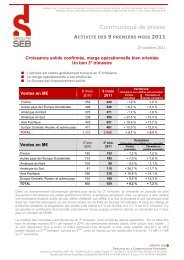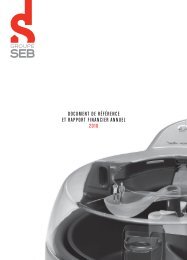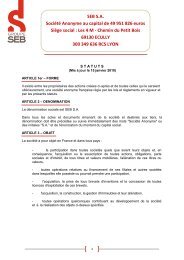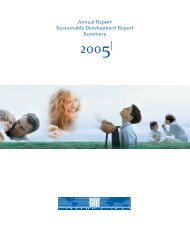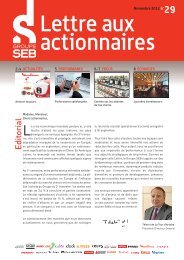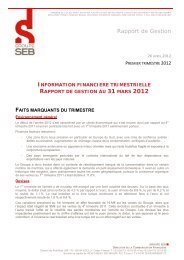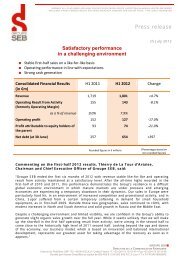financial report and registration document 2011 - Groupe SEB
financial report and registration document 2011 - Groupe SEB
financial report and registration document 2011 - Groupe SEB
You also want an ePaper? Increase the reach of your titles
YUMPU automatically turns print PDFs into web optimized ePapers that Google loves.
� respect for rules governing division of responsibilities;<br />
� policies applying to insurance cover <strong>and</strong> hedging;<br />
� fi nancial <strong>report</strong>ing audit principles.<br />
The risk analysis <strong>and</strong> internal control processes use two basic tools:<br />
� an annual “top-down” review <strong>and</strong> analysis of the main risks. In <strong>2011</strong>, the<br />
members of the Group Executive Committee, the Director of Legal Affairs,<br />
the Director of IT Systems, the Director of Quality, the President in charge<br />
of Innovation, the President in charge of Strategy, the Presidents of the<br />
three core business units <strong>and</strong> the President for China were interviewed<br />
individually to help identify <strong>and</strong> analyse the top ten risks that <strong>Groupe</strong> <strong>SEB</strong><br />
is or could be exposed to. Each risk was evaluated in terms of probability<br />
<strong>and</strong> impact, <strong>and</strong> actions to mitigate each risk were identifi ed. This resulted<br />
in the annual map of risks faced by <strong>Groupe</strong> <strong>SEB</strong>;<br />
� a “bottom-up” process involving self-assessment questionnaires, based<br />
on processes. These are sent out to each operational entity <strong>and</strong> are<br />
designed to identify possible weak points <strong>and</strong> encourage the practice<br />
of internal control at all levels, with a view to making Group operations<br />
more effi cient.<br />
Internal control participants<br />
THE BOARD OF DIRECTORS, THE AUDIT<br />
COMMITTEE AND THE NOMINATIONS<br />
AND REMUNERATION COMMITTEE<br />
The role of these bodies is described in the “Organisation <strong>and</strong> Operation of<br />
the Board of Directors” section, pages 26, 27 <strong>and</strong> 28.<br />
GROUP EXECUTIVE COMMITTEE AND GROUP<br />
MANAGEMENT BOARD<br />
Their role is described in the “Group Management Bodies” section, page 29.<br />
THE INTERNAL AUDIT DEPARTMENT<br />
Internal audit, as defined by professional st<strong>and</strong>ards, consists of<br />
“an independent <strong>and</strong> objective process which ensures that the Group has<br />
adequate control of its operations <strong>and</strong> which offers advice on improving the<br />
latter while contributing to added value. The internal audit function helps the<br />
Group to achieve its objectives by systematically <strong>and</strong> methodically evaluating<br />
its risk management, control <strong>and</strong> corporate governance procedures, <strong>and</strong><br />
through recommendations for their improvement.”<br />
The role of the <strong>Groupe</strong> <strong>SEB</strong> Internal Audit department is fully consistent<br />
with this approach.<br />
The Internal Audit department is responsible for evaluating, at all locations<br />
where the Group is established <strong>and</strong> for all functions, compliance with Group<br />
Internal Rules <strong>and</strong> procedures <strong>and</strong> any non-compliance with legislation, <strong>and</strong><br />
for ensuring that Group assets are protected. It is also required to evaluate<br />
the effi cient conduct of operations <strong>and</strong> to ensure that all business risks are<br />
anticipated <strong>and</strong> controlled.<br />
Financial Report <strong>and</strong> Registration Document <strong>2011</strong><br />
2<br />
Corporate governance<br />
Chairman’s <strong>report</strong> on internal control<br />
In <strong>2011</strong>, the self-assessment process was completed as in previous years,<br />
with one questionnaire every two years for each Group entity.<br />
Added to these two methods of evaluation are internal audits of all entities<br />
<strong>and</strong> of all the Group’s functions, as well as the annual <strong>and</strong> half-yearly reviews<br />
carried out by the Statutory auditors.<br />
In <strong>2011</strong>, the Internal Audit department carried out missions at 12 market<br />
companies representing 29% of the Group’s sales, <strong>and</strong> at three plants,<br />
representing 32% of Group production, <strong>and</strong> it analysed fi ve Group processes.<br />
The crisis management system, established in 2010, was put into action<br />
in <strong>2011</strong> in response to the natural disasters in Japan <strong>and</strong> Thail<strong>and</strong>.<br />
Improvements were made to the system based on these real-life situations.<br />
The parties involved underwent new training <strong>and</strong> are now equipped with<br />
additional <strong>document</strong>s that prepare them to deal with specifi c issues.<br />
In the area of risk management, the Internal Audit department draws up a<br />
map of high-level risks.<br />
Based on this map, on the self-assessment questionnaires <strong>and</strong> on the<br />
principle of an audit in each entity every three or four years, the Audit<br />
department proposes an internal audit plan for the following year.<br />
This plan is submitted to the Audit Committee.<br />
Each internal audit – adapted to circumstances <strong>and</strong> conducted locally by<br />
an average of three Auditors over a two-week period – gives rise to an audit<br />
<strong>report</strong> which is sent to the audited structures <strong>and</strong> their upline management,<br />
to the members of the Group Executive Committee <strong>and</strong> to the Group<br />
Chairman <strong>and</strong> CEO, describing the basic organisation of each process <strong>and</strong><br />
making recommendations.<br />
Steps are then taken by operational management to remedy identifi ed<br />
shortcomings in internal control, <strong>and</strong> to make any other necessary<br />
improvements. The implementation of resulting action plans is subjected to<br />
a systematic internal audit review within 12 months of the audit.<br />
The results of these audits are compared with the results of the selfassessments,<br />
thus completing the full circle of the internal control process.<br />
In order to ensure continuous improvement of internal control <strong>and</strong> Company<br />
effi ciency, the main recommendations issued by the Audit department for<br />
each process are shared annually with the Group Management Committee<br />
for the main Group divisions: Purchasing, IT, Quality, Finance, Human<br />
Resources, Supply Chain, Production, After-sales Service <strong>and</strong> Marketing.<br />
The Internal Audit department draws up an annual <strong>report</strong> of work done which<br />
is presented to the Group Executive Committee <strong>and</strong> the Audit Committee.<br />
The Audit Committee reviews the resources needed by the Internal<br />
Audit department to carry out its work, <strong>and</strong> makes observations or<br />
recommendations as required. The Internal Audit department has a staff<br />
of ten people.<br />
GROUPE <strong>SEB</strong><br />
2<br />
37



